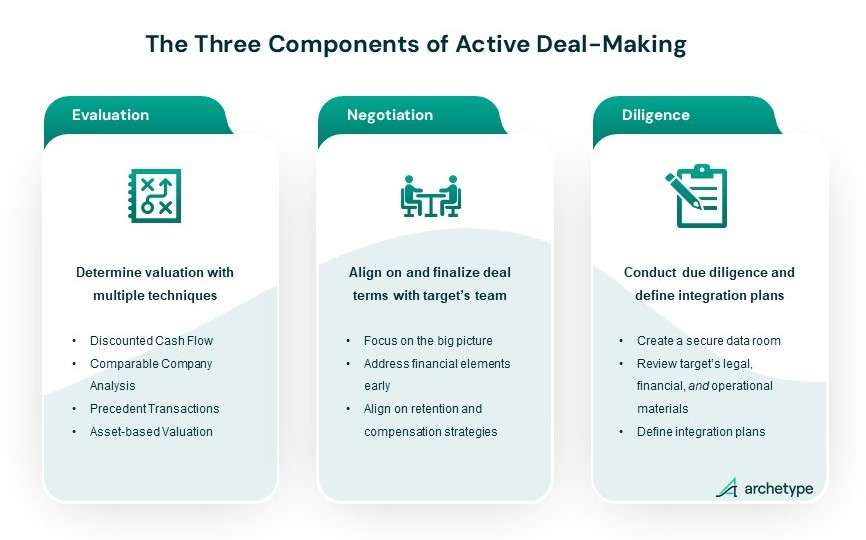A Strategic Guide for Growth-Oriented Leaders
By Sarah Brennan | August 2024
In the fast-paced world of mergers and acquisitions, a well-designed deal process is your secret weapon. It’s the difference between a smooth, value-creating transaction and a chaotic scramble that leaves money on the table. In the first part of our series, we explored the foundational elements of M&A strategy and how to align your strategic goals with potential acquisitions. Let’s dive into how you can craft a deal process that positions you for M&A success.
The Art of Evaluation
Once you have created your strategy and identified organizations to target, you now will need to evaluate the best opportunity for your growth. Valuation is a critical component of the M&A process. It transcends mere number-crunching; it requires a deep understanding of the unique value that the target can bring to your organization. To achieve this, it is essential to employ a variety of valuation techniques rather than relying on a single method.
Multiple Valuation Techniques and Value Creation
Valuation is not a one-size-fits-all approach for every situation. Instead, a combination of techniques should be used to arrive at a comprehensive understanding of the target’s worth and the potential value of the combined entity:
- Discounted Cash Flow (DCF): This forward-looking method considers the target’s future cash flows, discounted to present value.
- Comparable Company Analysis: Examine trading multiples of similar public companies.
- Precedent Transactions: Analyze recent M&A deals in your industry to gauge market prices.
- Asset-Based Valuation: Particularly useful for asset-heavy industries.
By triangulating a combination of these methods, you’ll arrive at a valuation range that’s both well-grounded and strategically sound. However, the valuation process doesn’t stop here.
A key part of the M&A process is understanding and modeling what will be different with the combined company. This involves:
- Identifying and quantifying potential synergies: Both revenue synergies (e.g., cross-selling opportunities, expanded market reach) and cost synergies (e.g., operational efficiencies, economies of scale).
- Assessing how these synergies will transform your competitive positioning.
- Modeling the impact of these changes on key performance metrics.
It’s crucial to establish clear methods for measuring the impact of these changes. This can involve tracking metrics such as revenue growth rate, cost savings, market share expansion, customer acquisition rates, and/or operational efficiency improvements. Remember, any deal should be accretive to overall value.
By rigorously analyzing where value creation opportunities lie and how they will be measured, you can:
- Justify a potentially higher purchase price.
- Align your strategic vision with the realities of the deal.
- Set clear post-merger integration goals and metrics.
- Ensure the deal contributes positively to your company’s overall value and performance.
This comprehensive approach to valuation and value creation will provide a solid foundation for your M&A strategy, helping to ensure that any acquisition you pursue is both strategically sound and financially beneficial.
Mastering the Negotiation Dance and Key Financial Considerations
With a solid valuation in hand, it’s time to engage with the target. While negotiation can be a delicate balance of flexibility and assertiveness, it’s crucial to address certain key financial elements early in the process. These include:
- Working Capital Peg: Establish a clear understanding of the expected working capital at closing. This ensures that the business is transferred with adequate operational funds and prevents post-closing disputes.
- Deferred Revenue Treatment: Determine how deferred revenue will be handled, particularly for prepaid contracts. It’s essential to account for the Cost of Goods Sold (COGS) associated with future deliverables on these contracts to avoid unexpected expenses post-acquisition.
With these financial considerations in mind, it’s crucial to focus on the big picture during initial negotiations. As you engage with the target company, strive to identify the potential deal breakers for both sides. The negotiation process typically revolves around several key areas that demand careful attention, such as the purchase price and structure. Equally important are the representations and warranties, which provide assurances about the state of the business, and the indemnification provisions that protect against unforeseen liabilities. Employee retention and compensation strategies also frequently emerge as critical points of negotiation, especially when key talent is vital to the target company’s value. By addressing these fundamental issues upfront, alongside the previously mentioned working capital and deferred revenue considerations, you lay the groundwork for more streamlined negotiations as the process unfolds. This proactive approach not only helps to avoid potential roadblocks later but also demonstrates your commitment to a fair and comprehensive deal structure.
Beyond negotiations, honest communication is crucial. Be clear about your intentions and the value you see in the target company. This doesn’t mean showing all your cards, but it does mean fostering an atmosphere of mutual respect and collaboration.
By mastering the negotiation process and addressing key financial considerations early, you’ll be better positioned to structure a deal that’s beneficial for both parties and sets the stage for a successful integration.

Structuring for Success
A well-structured deal process is the backbone of successful M&A transactions. It’s not something that happens by chance, but rather a carefully designed framework that sets you up for success. To create this structure, start by breaking the process into distinct phases with clear milestones, each with specific objectives and timelines. This approach provides a roadmap for your team and helps maintain momentum throughout the deal.
Central to this structure is a robust due diligence process. This is your opportunity to verify assumptions and uncover potential risks. While thoroughness is crucial, it’s equally important to avoid getting bogged down in unnecessary details. To facilitate this process, you should create a secure, digital deal room. These platforms streamline document sharing and collaboration, ensuring that all parties have access to the information they need when they need it.
Remember, even the best-laid plans can encounter unexpected hurdles. Build flexibility into your timeline and be prepared to adapt. Deals rarely go exactly as planned, so agility is an asset.
The power of preparation cannot be overstated in M&A. Before you even approach a target, ensure you have all your ducks in a row. This means having your financing lined up, your integration team ready to hit the ground running, and a detailed post-merger integration plan in place. This level of readiness not only accelerates the process but also demonstrates your seriousness and professionalism to the target company.
By focusing on these elements, you’ll be well positioned to navigate the complexities of M&A transactions. This approach not only increases your chances of success but also helps you create and capture value throughout the deal process.
Looking Ahead: Post-Deal Success
In the final installment of this series, we’ll delve into the critical post-deal activities that truly determine an acquisition’s success.
First, we will focus on executing your integration plan and then we will examine how to measure and track progress. Additionally, we will navigate the cultural integration challenges that often arise during mergers, as aligning different organizational cultures is vital for long-term success. Finally, we will establish key performance indicators (KPIs) to monitor the long-term success of the deal, ensuring that you can evaluate its impact on your organization over time. Together, these elements will provide a comprehensive framework for managing the complexities of post-merger integration and achieving sustainable growth.
